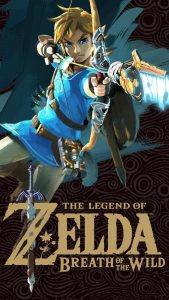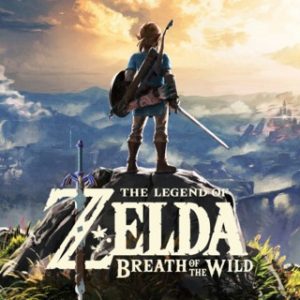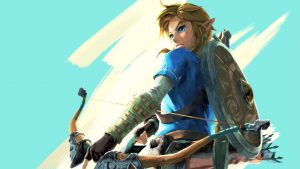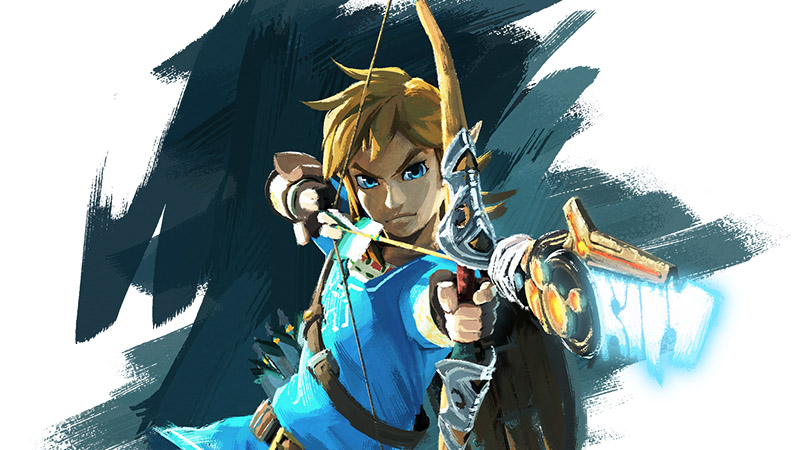The Legend of Zelda: Breath of the Wild
 It isn’t often that you bring home a game that is a legitimate contender for the title of Greatest Game Ever Made. Games, like books, are so personal and subjective that one player’s favorite feature could be the bane of another’s gaming existence. The reasons I abhor a game may very well be the reasons you love it. What Nintendo has done, with The Legend of Zelda: Breath of the Wild, is craft a game so unmistakably original yet so perfectly familiar as to defy most arguments of personal taste.
It isn’t often that you bring home a game that is a legitimate contender for the title of Greatest Game Ever Made. Games, like books, are so personal and subjective that one player’s favorite feature could be the bane of another’s gaming existence. The reasons I abhor a game may very well be the reasons you love it. What Nintendo has done, with The Legend of Zelda: Breath of the Wild, is craft a game so unmistakably original yet so perfectly familiar as to defy most arguments of personal taste.
As someone who has been playing video games since 1985, I’m confident in saying that The Legend of Zelda: Breath of the Wild is, perhaps, the best pure video game I’ve ever played. A stunning combination of gameplay, worldbuilding and storytelling that somehow defies convention while embracing 31 years of history, BOTW is a fantastical masterpiece that will sit at or near the top of any list of Greatest Games Ever Made for years to come.
Odds are if you’re visiting this website, you’re a fan of fantasy novels. You’re relatively well-read in the genre; you’ve been on r/fantasy or Tor.com or Fantasy-Faction. You know the score: magic, swords, sorcery, quests. Good versus Evil. Good versus Good. Evil versus Evil. Characters are born, live and die and have adventures in between. Some are paragons of virtue; others are dastardly villains hell-bent on domination. And many fall somewhere in between. And dragons. Most of the time there are a few dragons.
 All of what I’ve just described can easily be applied to The Legend of Zelda series. From its first 8-bit release on the NES in 1986 through BOTW in 2017, Zelda has been a fantasy series in video game garb. And whether you hearken back to Adventure, the Zork games or any number of other fantasy gaming classics, Zelda was neither the first nor the last of its kind. But what Zelda has that many series lack is an open-ended longevity and a willingness to take risks that could frustrate and alienate fans. For the most part, the risks Nintendo has taken have paid off. Missteps have been few, and hotly debated. And those 31 years of history have culminated in Breath of the Wild.
All of what I’ve just described can easily be applied to The Legend of Zelda series. From its first 8-bit release on the NES in 1986 through BOTW in 2017, Zelda has been a fantasy series in video game garb. And whether you hearken back to Adventure, the Zork games or any number of other fantasy gaming classics, Zelda was neither the first nor the last of its kind. But what Zelda has that many series lack is an open-ended longevity and a willingness to take risks that could frustrate and alienate fans. For the most part, the risks Nintendo has taken have paid off. Missteps have been few, and hotly debated. And those 31 years of history have culminated in Breath of the Wild.
The gameplay, on its surface, is not revolutionary. You run around, hit things with a sword and there are MAJOR QUESTS, Side Quests and little puzzles. The order in which you do things is completely up to you—maybe more so than in any other Zelda game. There are “dungeons” and “temples” and shrines and towns and odd, idiosyncratic supporting characters. There are bombs and boomerangs and literally thousands of other things to find. There is magic. There is a Master Sword. There is a land called Hyrule, a hero called Link and a princess called Zelda.
And still, BOTW feels new. Why? In a word: diversity.
Each puzzle, each quest, each shrine is different. And there is simply no right way to accomplish any given task. Nintendo is confident not only in their design, but in the ability of gamers to take that design and mold it to their own style of play. It is an ego-less way to develop a game, and the end result is the developers and players embarking hand-in-hand on a journey of discovery. I can’t imagine how the developers must feel seeing videos of gamers turning their game on its ear. Developing and releasing BOTW was simply the first step in the game’s evolution, and one month into its lifespan it has proven to be a game destined to take on a life of its own. It is a living, breathing thing—as dependent upon the skill and innovation of those who play it as it is upon the vision of those who designed it.
BOTW has embraced the cumulative history of Zelda and distilled it to its essence. They’ve acknowledged that where the player is going is a foregone conclusion . . . but how the player gets there? That’s the hook. Nintendo has created an open-world fantasy that is entirely dependent upon each individual gamer to maximize its potential. You get out of BOTW what you put into it. And here is where BOTW and the more familiar subjects of the Fantasy Hive intersect.
We’ve all read books or seen movies that have been lauded as classics by others, and yet when we read them, we’re left feeling a bit empty . . . and a bit foolish for not “getting” it. The Lord of the Rings has become ubiquitous. Star Wars is a touchstone of modern popular culture. Game of Thrones is one of the most successful television series in history. And even if they aren’t your cup of tea, you’re aware of them. They’ve permeated the collective consciousness. They are part of the vernacular.
Each of those works share that same trust in the consumer that BOTW exudes. There’s no “right” way to read The Lord of the Rings. There’s no right way to tackle the Star Wars Universe. You can simply read the words on the page, watch the pictures on the screen, and enjoy the story. Or you can dive deeper. Deeper into the back matter and spinoffs. Deeper into the lore and theories. Deeper into these living, breathing universes. There is so much material—both in the lines written and in the spaces between. You get out of these works what you put into them.

BOTW is like that, too.
On the surface, there is certainly a “main story” that progresses in a relatively linear fashion. And much like Frodo and the Fellowship have one overarching task, the ultimate point of BOTW is to reach Princess Zelda and defeat Ganon—the same vein Zelda has been mining since 1986. But dig a little deeper and things get more interesting.
BOTW has a narrative structure that is deceptively complex. Because it is an “open world” game, one that has no clear “right” way to do anything, the narrative is constructed in such a way that every event—from the smallest character interaction to the largest battle—is a story-within-the story. Each event or interaction is both a complete standalone narrative and part of the larger plot. The end result is a vast world that feels dynamic and alive. It is immersive on a level most games can only dream of, feeling less like a story unfolding and more like a world evolving.
For every hour I’ve played BOTW I feel like I’ve discovered another two hours’ worth of gameplay. And not in the onerous, boring “I need to do Task A just to get to Task B” way that many open world games force players to adhere too. No, much like when I read Lord of the Rings and wanted to delve deeper into the story of Isildur and Elendil, or the history of the Necromancer, the additional “work” BOTW offers is intriguing and ultimately fulfilling.

The animation style and diversity of environments Nintendo has chosen for BOTW also serve the game well. The animation is very upfront and noticeable, whilst still being clean, classic and not overly busy. There is a subtle but distinct anime influence that never wears on the eyes. The diversity of cultures the developers have drawn from—ranging from Feudal Japan to Medieval Europe to 19th century Mexico—is both refreshing and compelling. And that just covers humanity. There are talking birds, giant Gorons that live on a steady diet of rocks and monsters both living and undead populating the countryside, mountains, deserts and tundra. The story is unfolding in a world that is anything but homogenous, and even to lifelong Zelda players BOTW offers a new and compelling spin on characters that have been entertaining us for years.
The introduction of voice acting in cut scenes has also elevated the narrative to new heights. The biggest benefactor of this shift in stylistic philosophy is Princess Zelda herself, who is revealed in BOTW to be a character of vast complexity—she is no damsel in distress, and yet she is no paragon of virtue either. Zelda’s story and Link’s are inextricably tied, but they are two very different stories. Zelda’s frustration, anger, hubris and jealousy are expertly conveyed through both animation and voice acting and her reimagining as a decidedly flawed, imperfect person is perhaps the most rewarding aspect of the tale being told. There is a desperation to BOTW that is very true to life, and that desperate tone sets BOTW apart from every Zelda that has come before.
I could wax poetic on BOTW for another 1500 words and I still wouldn’t be scratching the surface. On the most basic of levels, BOTW is a clinic in video game design. Gameplay is fun and engaging. The worldbuilding is masterful. And the story is one for the ages. The Legend of Zelda: Breath of the Wild is one of those rare games that all but the most jaded of gamers will love. The sum of its parts—some of which are imperfect, to be sure—is far greater than any individual aspect of the game.
Whether you’re an avid gamer and lifelong Zelda fan or you’re a casual player who enjoys a good story, Breath of the Wild is for you. Whether you’re a completionist or a speed runner, Breath of the Wild is for you. Whether you yearn for the pre-grimdark days or revel in the darker corners of the fantastic, Breath of the Wild is for you. If you love fun, if you love adventure, if you love a tale well told, Breath of the Wild is for you.
The Legend of Zelda: Breath of the Wild is that rare perfect convergence of gameplay, narrative and design. It imbues the player with a level of trust and responsibility that many games sacrifice on the altar of instant gratification.
It is, perhaps, the best game I’ve ever played.

This article appeared first on Fantasy-Faction on April 5, 2017.
